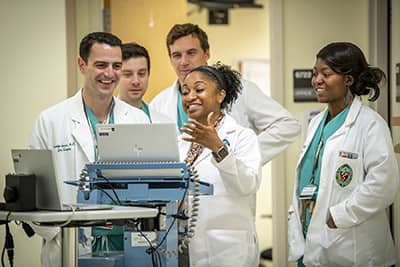 While the first year of medical school involves learning the normal function of the human body, the second year focuses on the anatomic changes associated with disease and the symptoms that are typically correlated with specific diseases covering every organ system. From bronchitis and cataracts, to heart disease and osteoporosis, students in the second year begin to learn the skill of developing a differential diagnosis. This involves synthesizing a patient’s presenting symptoms along with the physical exam to formulate the probability of which diseases would most likely be causing the patient’s symptoms and physical findings. To develop this skill, students must practice interviewing patients about their symptoms as well as examining them (known as “performing a history and physical.”) To become proficient in this skill, it takes many months (and years to master) of practice knowing what other questions to ask the patient in addition to the information the patient provides. Exam skills must be taught, and students learn and practice these techniques on patient actors here at Tulane known as Standardized Patients. The Standardized Patient Center trains these actors to replicate a given disease’s presentation, teaches them the basic anatomy and pathology involved, and instructs them on providing feedback to the students about their skills. Students also practice their technical skills on mannequins with sophisticated technology during their time in our Simulation Center in the Murphy Building. Both Centers prepare the students for their real patient interviews and exams which are performed under the guidance of their physician preceptors at the hospitals. While this skill is one of the overarching objectives of the second year, the ability to develop a differential diagnosis is not possible unless the student learns the presentation of nearly every disease in every organ system. The second year, just as the first, is arranged in organ system modules. Both basic science (PhD) and clinical (MD) professors are involved in the teaching sessions for each module, but the student must spend long hours learning disease presentations as well as comparing and contrasting them with other diseases that might present with similar findings. Exams are held roughly every three weeks, and many students consider the second year the hardest of all based on the amount of information that must be learned in a short period of time. Like the first-year students, T2 students don’t have much time to chat or text, but they would appreciate your remembering them during exam time with an e-card or some other gesture of support. The end of second year in February brings on the scheduling and dedicated study time for the infamous Step 1 exam, a national licensure exam that all medical students must pass in order to move forward and graduate. But we will talk about that in the next newsletter…
While the first year of medical school involves learning the normal function of the human body, the second year focuses on the anatomic changes associated with disease and the symptoms that are typically correlated with specific diseases covering every organ system. From bronchitis and cataracts, to heart disease and osteoporosis, students in the second year begin to learn the skill of developing a differential diagnosis. This involves synthesizing a patient’s presenting symptoms along with the physical exam to formulate the probability of which diseases would most likely be causing the patient’s symptoms and physical findings. To develop this skill, students must practice interviewing patients about their symptoms as well as examining them (known as “performing a history and physical.”) To become proficient in this skill, it takes many months (and years to master) of practice knowing what other questions to ask the patient in addition to the information the patient provides. Exam skills must be taught, and students learn and practice these techniques on patient actors here at Tulane known as Standardized Patients. The Standardized Patient Center trains these actors to replicate a given disease’s presentation, teaches them the basic anatomy and pathology involved, and instructs them on providing feedback to the students about their skills. Students also practice their technical skills on mannequins with sophisticated technology during their time in our Simulation Center in the Murphy Building. Both Centers prepare the students for their real patient interviews and exams which are performed under the guidance of their physician preceptors at the hospitals. While this skill is one of the overarching objectives of the second year, the ability to develop a differential diagnosis is not possible unless the student learns the presentation of nearly every disease in every organ system. The second year, just as the first, is arranged in organ system modules. Both basic science (PhD) and clinical (MD) professors are involved in the teaching sessions for each module, but the student must spend long hours learning disease presentations as well as comparing and contrasting them with other diseases that might present with similar findings. Exams are held roughly every three weeks, and many students consider the second year the hardest of all based on the amount of information that must be learned in a short period of time. Like the first-year students, T2 students don’t have much time to chat or text, but they would appreciate your remembering them during exam time with an e-card or some other gesture of support. The end of second year in February brings on the scheduling and dedicated study time for the infamous Step 1 exam, a national licensure exam that all medical students must pass in order to move forward and graduate. But we will talk about that in the next newsletter…
To view the T2 exam schedule, click here: https://medicine.tulane.edu/education/undergraduate-medical-education/curriculum/year-2-important-dates
For more on the Standardized Patient program: https://medicine.tulane.edu/standardized-patient
For more on the Simulation Center: https://medicine.tulane.edu/centers-institutes/simcenter
